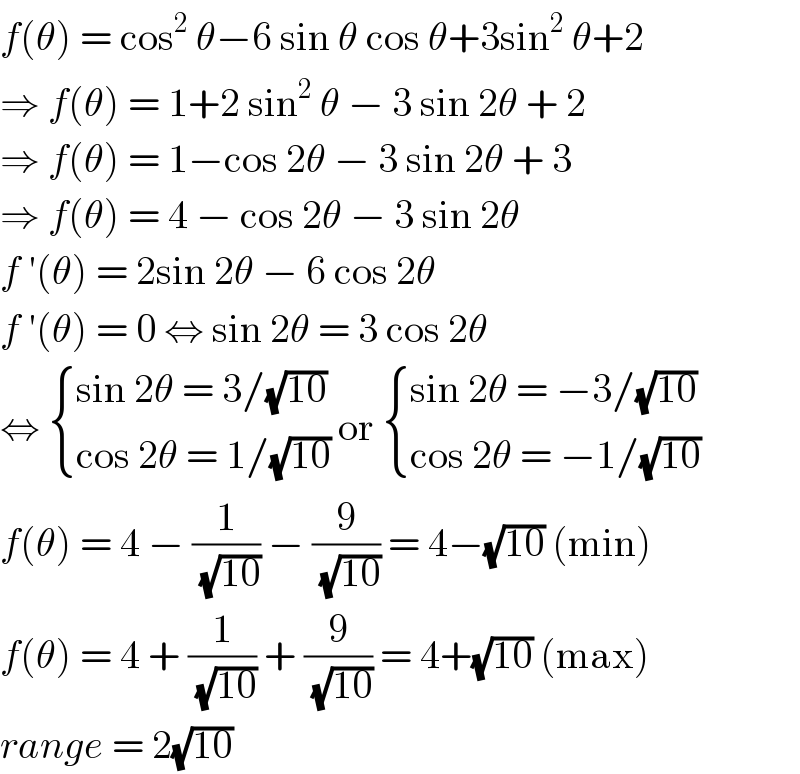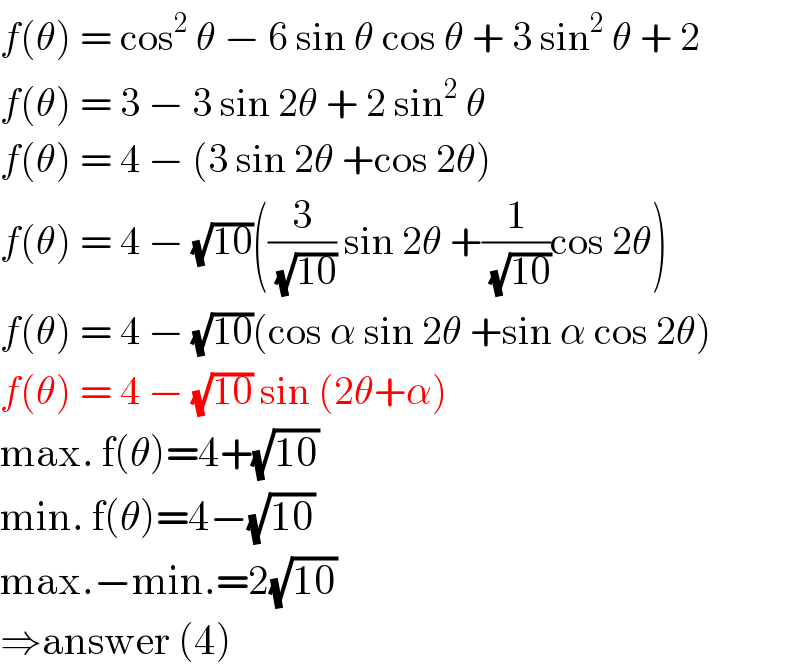
Question Number 20653 by Tinkutara last updated on 30/Aug/17

$$\mathrm{Length}\:\mathrm{of}\:\mathrm{interval}\:\mathrm{of}\:\mathrm{range}\:\mathrm{of}\:\mathrm{function} \\ $$$${f}\left(\theta\right)\:=\:\mathrm{cos}^{\mathrm{2}} \:\theta\:−\:\mathrm{6}\:\mathrm{sin}\:\theta\:\mathrm{cos}\:\theta\:+\:\mathrm{3}\:\mathrm{sin}^{\mathrm{2}} \:\theta\:+\:\mathrm{2} \\ $$$$\mathrm{is} \\ $$$$\left(\mathrm{1}\right)\:\mathrm{8} \\ $$$$\left(\mathrm{2}\right)\:−\mathrm{8} \\ $$$$\left(\mathrm{3}\right)\:\sqrt{\mathrm{10}} \\ $$$$\left(\mathrm{4}\right)\:\mathrm{2}\sqrt{\mathrm{10}} \\ $$
Answered by dioph last updated on 31/Aug/17

$${f}\left(\theta\right)\:=\:\mathrm{cos}^{\mathrm{2}} \:\theta−\mathrm{6}\:\mathrm{sin}\:\theta\:\mathrm{cos}\:\theta+\mathrm{3sin}^{\mathrm{2}} \:\theta+\mathrm{2} \\ $$$$\Rightarrow\:{f}\left(\theta\right)\:=\:\mathrm{1}+\mathrm{2}\:\mathrm{sin}^{\mathrm{2}} \:\theta\:−\:\mathrm{3}\:\mathrm{sin}\:\mathrm{2}\theta\:+\:\mathrm{2} \\ $$$$\Rightarrow\:{f}\left(\theta\right)\:=\:\mathrm{1}−\mathrm{cos}\:\mathrm{2}\theta\:−\:\mathrm{3}\:\mathrm{sin}\:\mathrm{2}\theta\:+\:\mathrm{3} \\ $$$$\Rightarrow\:{f}\left(\theta\right)\:=\:\mathrm{4}\:−\:\mathrm{cos}\:\mathrm{2}\theta\:−\:\mathrm{3}\:\mathrm{sin}\:\mathrm{2}\theta \\ $$$${f}\:'\left(\theta\right)\:=\:\mathrm{2sin}\:\mathrm{2}\theta\:−\:\mathrm{6}\:\mathrm{cos}\:\mathrm{2}\theta \\ $$$${f}\:'\left(\theta\right)\:=\:\mathrm{0}\:\Leftrightarrow\:\mathrm{sin}\:\mathrm{2}\theta\:=\:\mathrm{3}\:\mathrm{cos}\:\mathrm{2}\theta \\ $$$$\Leftrightarrow\:\begin{cases}{\mathrm{sin}\:\mathrm{2}\theta\:=\:\mathrm{3}/\sqrt{\mathrm{10}}}\\{\mathrm{cos}\:\mathrm{2}\theta\:=\:\mathrm{1}/\sqrt{\mathrm{10}}}\end{cases}\:\mathrm{or}\:\begin{cases}{\mathrm{sin}\:\mathrm{2}\theta\:=\:−\mathrm{3}/\sqrt{\mathrm{10}}}\\{\mathrm{cos}\:\mathrm{2}\theta\:=\:−\mathrm{1}/\sqrt{\mathrm{10}}}\end{cases} \\ $$$${f}\left(\theta\right)\:=\:\mathrm{4}\:−\:\frac{\mathrm{1}}{\sqrt{\mathrm{10}}}\:−\:\frac{\mathrm{9}}{\sqrt{\mathrm{10}}}\:=\:\mathrm{4}−\sqrt{\mathrm{10}}\:\left(\mathrm{min}\right) \\ $$$${f}\left(\theta\right)\:=\:\mathrm{4}\:+\:\frac{\mathrm{1}}{\sqrt{\mathrm{10}}}\:+\:\frac{\mathrm{9}}{\sqrt{\mathrm{10}}}\:=\:\mathrm{4}+\sqrt{\mathrm{10}}\:\left(\mathrm{max}\right) \\ $$$${range}\:=\:\mathrm{2}\sqrt{\mathrm{10}} \\ $$
Commented by dioph last updated on 31/Aug/17

$$\mathrm{I}\:\mathrm{am}\:\mathrm{sorry},\:\mathrm{I}\:\mathrm{forgot}\:\mathrm{to}\:\mathrm{add}\:\mathrm{1},\:\mathrm{it}\:\mathrm{is} \\ $$$$\mathrm{corrected} \\ $$
Answered by mrW1 last updated on 31/Aug/17

$${f}\left(\theta\right)\:=\:\mathrm{cos}^{\mathrm{2}} \:\theta\:−\:\mathrm{6}\:\mathrm{sin}\:\theta\:\mathrm{cos}\:\theta\:+\:\mathrm{3}\:\mathrm{sin}^{\mathrm{2}} \:\theta\:+\:\mathrm{2} \\ $$$${f}\left(\theta\right)\:=\:\mathrm{3}\:−\:\mathrm{3}\:\mathrm{sin}\:\mathrm{2}\theta\:+\:\mathrm{2}\:\mathrm{sin}^{\mathrm{2}} \:\theta\: \\ $$$${f}\left(\theta\right)\:=\:\mathrm{4}\:−\:\left(\mathrm{3}\:\mathrm{sin}\:\mathrm{2}\theta\:+\mathrm{cos}\:\mathrm{2}\theta\right) \\ $$$${f}\left(\theta\right)\:=\:\mathrm{4}\:−\:\sqrt{\mathrm{10}}\left(\frac{\mathrm{3}}{\sqrt{\mathrm{10}}}\:\mathrm{sin}\:\mathrm{2}\theta\:+\frac{\mathrm{1}}{\sqrt{\mathrm{10}}}\mathrm{cos}\:\mathrm{2}\theta\right) \\ $$$${f}\left(\theta\right)\:=\:\mathrm{4}\:−\:\sqrt{\mathrm{10}}\left(\mathrm{cos}\:\alpha\:\mathrm{sin}\:\mathrm{2}\theta\:+\mathrm{sin}\:\alpha\:\mathrm{cos}\:\mathrm{2}\theta\right) \\ $$$${f}\left(\theta\right)\:=\:\mathrm{4}\:−\:\sqrt{\mathrm{10}}\:\mathrm{sin}\:\left(\mathrm{2}\theta+\alpha\right) \\ $$$$\mathrm{max}.\:\mathrm{f}\left(\theta\right)=\mathrm{4}+\sqrt{\mathrm{10}} \\ $$$$\mathrm{min}.\:\mathrm{f}\left(\theta\right)=\mathrm{4}−\sqrt{\mathrm{10}} \\ $$$$\mathrm{max}.−\mathrm{min}.=\mathrm{2}\sqrt{\mathrm{10}} \\ $$$$\Rightarrow\mathrm{answer}\:\left(\mathrm{4}\right) \\ $$
Commented by Tinkutara last updated on 31/Aug/17

$$\mathrm{Thank}\:\mathrm{you}\:\mathrm{very}\:\mathrm{much}\:\mathrm{Sir}! \\ $$
